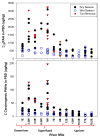Estimating risk at a Superfund site using passive sampling devices as biological surrogates in human health risk models
- PMID: 21741671
- PMCID: PMC3671909
- DOI: 10.1016/j.chemosphere.2011.06.051
Estimating risk at a Superfund site using passive sampling devices as biological surrogates in human health risk models
Abstract
Passive sampling devices (PSDs) sequester the freely dissolved fraction of lipophilic contaminants, mimicking passive chemical uptake and accumulation by biomembranes and lipid tissues. Public Health Assessments that inform the public about health risks from exposure to contaminants through consumption of resident fish are generally based on tissue data, which can be difficult to obtain and requires destructive sampling. The purpose of this study is to apply PSD data in a Public Health Assessment to demonstrate that PSDs can be used as a biological surrogate to evaluate potential human health risks and elucidate spatio-temporal variations in risk. PSDs were used to measure polycyclic aromatic hydrocarbons (PAHs) in the Willamette River; upriver, downriver and within the Portland Harbor Superfund megasite for 3 years during wet and dry seasons. Based on an existing Public Health Assessment for this area, concentrations of PAHs in PSDs were substituted for fish tissue concentrations. PSD measured PAH concentrations captured the magnitude, range and variability of PAH concentrations reported for fish/shellfish from Portland Harbor. Using PSD results in place of fish data revealed an unacceptable risk level for cancer in all seasons but no unacceptable risk for non-cancer endpoints. Estimated cancer risk varied by several orders of magnitude based on season and location. Sites near coal tar contamination demonstrated the highest risk, particularly during the dry season and remediation activities. Incorporating PSD data into Public Health Assessments provides specific spatial and temporal contaminant exposure information that can assist public health professionals in evaluating human health risks.
Copyright © 2011 Elsevier Ltd. All rights reserved.
Figures



References
-
- Adams RG, Lohmann R, Fernandez LA, Macfarlane JK, Gschwend PM. Polyethylene devices: Passive samplers for measuring dissolved hydrophobic organic compounds in aquatic environments. Environ Sci Technol. 2007;41:1317–1323. - PubMed
-
- Allan IJ, Booij K, Paschke A, Vrana B, Mills GA, Greenwood R. Field Performance of Seven Passive Sampling Devices for Monitoring of Hydrophobic Substances. Environ Sci Technol. 2009;43:5383–5390. - PubMed
-
- Anderson KA, Sethajintanin D, Sower G, Quarles L. Field Trial and Modeling of Uptake Rates of In Situ Lipid-Free Polyethylene Membrane Passive Sampler. Environ Sci Technol. 2008;42:4486–4493. - PubMed
-
- ATSDR. Public Health Assessment Guidance Manual (2005 Update) ATSDR; Atlanta, GA: 2005. Available on line at http://www.atsdr.cdc.gov/hac/PHAManual.
-
- ATSDR, U.D.o.H.a.H.S. Public Health Assessment: Portland Harbor, Multnomah County, Oregon, EPA Facility ID: OR0001297969. Oregon Department of Human Services Superfund Health Investigation and Education Program, U.S. Department of Health and Human Services, Agency for Toxic Substances and Disease Registry; Atlanta, GA: 2006.
Publication types
MeSH terms
Substances
Grants and funding
LinkOut - more resources
Full Text Sources

